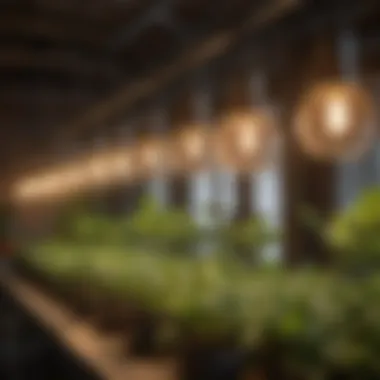Understanding Plant Growing Lamps: An In-Depth Exploration


Intro
Plant growing lamps have become essential tools in today’s horticultural practices, bridging the gap between natural sunlight and artificial growing conditions. As more individuals venture into gardening, whether for personal enjoyment or commercial purposes, understanding the nuances of these lamps is critical. This section explores the fundamental aspects of plant growing lamps, their significance, and how they contribute to healthier plant growth.
The investment in proper lighting can determine the success of both amateur gardeners and professional farmers alike. As research advances, innovations in lamp technology have emerged, enhancing the ability of plants to thrive under artificial conditions. This exploration presents a holistic view of plant growing lamps and their role in modern agriculture.
Topic Overview
Definition and Importance
Plant growing lamps are specialized light sources designed to simulate the sun’s spectrum for plant growth when natural light is limited or inadequate. Their importance lies in the ability to support photosynthesis, the process through which plants convert light into energy. In controlled environments, such as greenhouses or indoor gardens, these lamps ensure healthy development, leading to higher yields.
Key aspects to understand include:
- Types of Lamps: Each type serves unique purposes, from seed starting to flowering stages.
- Light Spectrum: Different wavelengths affect plant growth in varied ways, influencing flowering, root development, and other crucial processes.
- Energy Efficiency: Eco-friendly options can reduce electricity costs while supporting sustainable practices.
Brief History and Evolution
Historically, farmers relied solely on sunlight for plant growth. However, as agriculture evolved and technology advanced, the need for artificial lighting grew. Early models included simple incandescent bulbs, which were soon replaced by more effective fluorescent lamps. The development of high-intensity discharge (HID) lamps marked a significant advancement, providing stronger light and better energy efficiency.
More recently, light-emitting diodes (LEDs) have revolutionized the market. Their longer lifespan, lower energy consumption, and ability to produce specific light spectra tailored for various growth phases have made them a favored option among growers.
Key Techniques and Innovations
Sustainable Farming Practices
Sustainable agriculture emphasizes maintaining environmental health alongside productivity. Integrating plant growing lamps into sustainable practices can minimize the ecological footprint. Techniques include:
- Utilizing Renewable Energy: Using solar panels to power lighting systems can reduce dependence on fossil fuels.
- Adjustable Spectrum Lighting: Varied wavelengths can be adjusted according to the plants’ needs, promoting efficient energy usage.
Advanced Agronomic Technologies
Technological innovations are transforming how farmers use light. Notable advancements include:
- Smart Controllers: Automating light schedules and intensity based on real-time data improves plant health.
- Data Analytics: Monitoring growth patterns through data collection helps optimize lamp usage.
Practical Applications
Step-by-Step Guides
Implementing plant growing lamps effectively involves understanding the requirements of the plants and the specifics of the lighting system. A fundamental guide includes:
- Determine Plant Needs: Assess light requirements specific to each plant species.
- Select Lamp Type: Choose from LED, fluorescent, or HID lights based on budget and effectiveness.
- Set Proper Distance: Ensure lamps are positioned correctly to avoid light burn or inadequate exposure.
- Monitor Growth: Regularly check plant health and adjust light settings as necessary.
Case Studies or Real-World Examples
A notable example of effective lamp use can be found in urban rooftop gardens that utilize LED lighting. Growers in cities like New York or London have successfully used these lamps to produce vegetables year-round.
"By using LEDs in our rooftop farm, we maximize our space and extend the growing season seamlessly."
— Jane Doe, Urban Gardener.
Prolusion to Plant Growing Lamps
Plant growing lamps have become indispensable in horticulture. Their role in promoting plant growth and assisting in agricultural practices cannot be overstated. These devices mimic sunlight, offering illumination tailored to a plant's needs regardless of time or season. This capability is crucial for enthusiasts and professionals alike, enabling them to cultivate crops indoors or in environments where natural sunlight is inadequate.
The increasing interest in home gardening and sustainable farming practices has driven the demand for effective lighting systems. As urban spaces expand, many people seek to grow their own food and ornamental plants without traditional outdoor space. Illuminateing such ventures is where plant growing lamps prove their significance.
Purpose and Importance
The primary purpose of plant growing lamps is to provide light that enhances photosynthesis. This is essential for plant health, directly impacting their growth rate, flowering, and fruiting. The relevance of using the appropriate light cannot be overlooked. Different plants require specific light spectrums at various growth stages. Notably, some thrive under full spectrum light, while others do better with specific wavelengths.
Moreover, using these lamps optimizes growth conditions.
- Extended growing seasons allow for year-round cultivation, breaking free from seasonal limitations.
- Enhanced crop yields result from controlled light exposure, achieving better growth outcomes.
- Adaptation to varying plant requirements ensures diverse plants can be grown together successfully.
Additionally, plant growing lamps also cater to the growing trend of energy efficiency and sustainability. As scientists and manufacturers innovate, more environmentally friendly options are emerging alongside techniques designed to reduce energy consumption.
"Plant growing lamps not only support plant health but also revolutionize how we approach farming in limited spaces."
Types of Plant Growing Lamps


Plant growing lamps are essential tools in modern horticulture. They provide artificial light, enabling plants to grow even without natural sunlight. Understanding different types of plant growing lamps is important for selecting the right one for specific planting needs. Each type of lamp presents unique benefits and considerations that can influence plant health, growth speed, and overall yield.
Incandescent Lights
Incandescent lights are common in many household settings. They produce light by heating a metal filament until it glows. While these lights are affordable and easy to find, they are not very energy-efficient. Most of the energy they consume is converted into heat rather than light. This can lead to overheating and potential harm to some plants.
Their light spectrum is not optimal for plant growth. Therefore, although they can support plant growth, they are not regarded as the best option for serious gardeners or farmers.
Fluorescent Lights
Fluorescent lights are another popular choice for plant growth. These lights use an electric current to excite mercury vapor, producing ultraviolet light. This gas then creates visible light when coated with phosphor, making it more energy-efficient than incandescent lights. They are available in different types, such as T5, T8, and T12, with T5 being the most efficient type for plant growth due to their higher lumen output.
Fluorescent lights emit a broader spectrum of light, which can be advantageous for promoting photosynthesis. These lights are typically used in smaller plant setups, like indoor herb gardens. They are ideal for seedlings and young plants but may not be sufficient for more mature plants requiring higher light intensity.
LED Lights
LED lights have gained popularity in recent years. Their energy efficiency is one of their most significant benefits. LEDs consume less electricity and generate very little heat compared to other lamp types. This makes them safer for plants and reduces the need for additional cooling.
The light spectrum emitted by LED lights can be tailored to meet the specific needs of various plants. Some LEDs cover the entire light spectrum, while others focus on the blue and red wavelengths that plants use most efficiently during photosynthesis. This versatility allows growers to create optimal environments for different plant types. However, the initial investment cost for LED lights can be higher than other types, which may deter some users.
High-Intensity Discharge (HID) Lamps
HID lamps are often used in larger-scale agricultural production. These lamps produce a significant amount of light and can support vigorous plant growth. They use electricity to create an arc between two electrodes. This process generates light while producing heat that can be beneficial in cooler environments.
There are two main types of HID lamps: Metal Halide (MH) and High-Pressure Sodium (HPS). MH lamps emit a balanced spectrum suitable for vegetative growth, while HPS lamps are more effective for flowering and fruiting. Each type of HID lamp has distinct advantages depending on the growth stage of the plants. However, they require careful placement and may need additional cooling solutions due to the high heat they generate.
The Science of Light and Plant Growth
Understanding the relationship between light and plant growth is crucial for optimizing agricultural practices. Light does not merely enable visibility; it is a fundamental resource for photosynthesis, the bioprocess through which plants convert light energy into chemical energy. This section will discuss the intricacies of the photosynthesis process and the significance of different light spectra to plant health and development.
Photosynthesis Process
Photosynthesis is a complex sequence of reactions that occur in a plant's leaves. It primarily involves chlorophyll, a pigment that absorbs light efficiently. During this process, plants take in carbon dioxide from the air and water from the soil. When exposed to sufficient light, chlorophyll captures energy from this light.
The basic equation for photosynthesis can be summarized as:
[ 6CO_2 + 6H_2O + light ightarrow C_6H_12O_6 + 6O_2 ]
In simple terms, this means that six molecules of carbon dioxide and six molecules of water, when combined with light energy, produce one molecule of glucose and six molecules of oxygen. This glucose serves as the primary energy source for the plant, fueling its growth and sustaining its metabolic processes.
The efficiency of photosynthesis is heavily influenced by light intensity, duration, and quality. Each plant species has specific light requirements, and recognizing these can improve growth outcomes. For example, some plants thrive under direct sunlight, while others prefer diffused light conditions. This variance emphasizes the need for appropriate lighting methods, especially in controlled environments like greenhouses or indoor gardens.
Light Spectrum and Plants
Plants respond to different wavelengths of light in distinct ways. Natural sunlight provides a full spectrum of light, including ultraviolet (UV), visible, and infrared (IR) light. However, not all wavelengths are equally effective for photosynthesis.
- Blue Light (400-500 nm): This range supports vegetative growth. It promotes leaf development and helps in chlorophyll production, thus enhancing photosynthetic efficiency.
- Red Light (600-700 nm): Red light is essential during the flowering and fruiting stage. It encourages blooming and fruit set and is often utilized in combination with blue light to optimize plant growth.
- Green Light (500-600 nm): While plants reflect much of the green light, it still plays an important role in growth by penetrating deeper into foliage, aiding in overall plant health.
"The specific light spectrum used can greatly influence plant morphology, leading to significant differences in growth patterns and yields."
For optimal growth, many plant growers often employ artificial lighting solutions that can simulate the full light spectrum. Understanding these light spectrum characteristics enables gardeners and farmers to tailor their lighting setups to meet the distinct needs of their plants.
Optimal Light Conditions for Different Plants
Understanding the optimal light conditions for various plants is crucial for successful cultivation. Each plant species has its own light requirements that influence its growth and health. This section explores the elements that define these optimal conditions, the benefits associated with meeting these needs, and the practical considerations every grower must keep in mind.
Understanding Plant Needs
Plants rely on light to perform photosynthesis, the process by which they convert light energy into chemical energy. Therefore, knowing specific needs of plants is essential. The following factors play a significant role:
- Light Intensity: Different plants require varying intensity of light for optimal growth. For example, succulents and cacti thrive in bright, direct light, while shade-loving plants prefer lower intensities.
- Light Duration: The amount of time a plant is exposed to light affects its development. Some plants flourish under long hours of light, while others need periods of darkness to maintain their growth cycle.
- Light Quality: The spectrum of light is significant too. Plants utilize different wavelengths for different processes. Blue light supports leaf and stem growth, whereas red light promotes flowering and fruiting.
Identifying Light Requirements
Assessing the light requirements of plants involves observation and knowledge about different species. Here are some strategies:
- Researching Plant Species: Understanding the light preferences of each plant type is the first step. Publications, such as those found on Wikipedia or Britannica, provide data on specific species.
- Monitoring Growth Patterns: Keep an eye on how plants respond to the available light in their environment. If they are stretching towards the light or showing pale leaves, this might indicate insufficient light.
- Using Light Meters: Devices that measure light intensity can help quantitate how much light is available, assisting in determining if conditions meet the needs of the plants.
- Adjusting Based on Growth Stage: Seedlings may require different light conditions compared to mature plants. Adjusting light exposure during these stages can lead to healthier, more productive plants.
"Understanding the unique light needs of each plant is the foundation of successful cultivation."


Setting Up a Plant Growing Lamp
Setting up a plant growing lamp is critical for maximizing plant growth and health, especially in indoor environments. It involves more than just buying a lamp and turning it on. Proper setup ensures that your plants receive the right type and amount of light, which is essential for photosynthesis. Some plants require more light than others. Understanding your plant’s needs can greatly impact its growth potential.
Effective setup will contribute to a successful indoor gardening experience. It affects how well plants grow, how much energy you will use, and overall productivity.
Choosing the Right Lamp
Choosing the right lamp is the cornerstone of a successful indoor growing setup. Different types of plants have varied light requirements. For instance, leafy greens like lettuce may thrive under fluorescent lights, while flowering plants often prefer LED lights for their spectrum and intensity. Each lamp type has its advantages and disadvantages.
- Incandescent Lights are inexpensive but inefficient, producing more heat than light. They are rarely recommended for serious growers.
- Fluorescent Lights are better; they provide good spectrum and are energy efficient. They are often great for seedlings and low-light plants.
- LED Lights stand out for their energy efficiency and longevity. They can be tailored to specific plant needs through color spectrum manipulation.
- High-Intensity Discharge (HID) Lamps are powerful but require proper ventilation because of the heat they generate. They are typically used for high-density flowering plants.
Considering these aspects will help you narrow down the choices.
Positioning and Distance from Plants
Proper positioning of your growing lamp is vital. The effectiveness of a lamp diminishes with distance. Placing a lamp too far can result in inadequate light penetration, while too close can burn the plants.
- LED Lights are generally cooler and can be positioned closer to plants, often within 12 inches.
- HID Lamps should be kept at least 24 inches away from the plant canopy due to their intensity.
- Fluorescent Lights can be kept about 6-12 inches away, depending on the type.
Adjust the height based on your plant's growth stage. Seedlings require less intense light than mature plants, so be prepared to shift the lamp upwards as they grow. This allows you to promote even growth and avoid stretching.
Timing and Duration of Light Exposure
Timing plays a crucial role in plant growth as well. Most plants function on a photoperiod, meaning they have specific light and dark cycles. Knowing the right timing ensures optimal growth and health.
- Seedlings typically need around 16-18 hours of light per day.
- Mature plants may need about 12-16 hours, especially during flowering stages.
It's helpful to use timers to automate the light exposure. This eliminates the need for manual intervention and ensures consistency. A regular schedule helps simulate natural conditions, which can lead to better growth.
In summary, setting up a plant growing lamp is not just a task; it’s a strategic approach to plant care. The right lamp, correct positioning, and proper timing can all drastically improve plant health and productivity.
Advantages of Using Plant Growing Lamps
Plant growing lamps serve as a pivotal resource in modern horticulture and agriculture. Their contributions are multifaceted and can greatly enhance the growth and viability of plants. These lamps foster conditions that mimic ideal natural environments, offering crucial support to both amateur gardeners and seasoned farmers. Understanding the advantages of these lamps provides insights that can inform better practices in plant care.
Extended Growing Seasons
One of the primary advantages of using plant growing lamps is the ability to extend the growing season. In regions where seasonal changes limit cultivation, artificial light becomes indispensable. Grow lamps allow for the manipulation of light cycles, enabling plants to receive adequate lighting even during shorter days. This artificial extension is crucial for crops that require longer periods of light for optimal growth.
By strategically employing plant growing lamps, growers can start their planting earlier in spring and continue harvesting later into fall. This is especially beneficial for sensitive crops like tomatoes and peppers, which thrive in warmer months but can struggle with cooler temperatures. Investors in plant growing lamps often notice not just a longer season, but also more resilient plants that adapt better to varied conditions.
Considerations for maximizing extended seasons include:
- Lamp selection: Ensuring that the quality of light matches the needs of different plants.
- Placement: Adjusting the height and position of lamps to cover all plants evenly.
- Monitoring growth cycles: Keeping track of how different plants respond to extended light exposure can help refine practices.
Increased Yield and Quality
Another significant benefit of utilizing plant growing lamps is the increase in yield and quality of crops. When plants receive the appropriate spectrum of light, their photosynthetic activity intensifies. This leads to greater biomass accumulation and higher fruit or vegetable production. Healthier plants that receive adequate light are less susceptible to diseases and pests, contributing further to overall quality.
In pursuit of increased yield, selecting the right lamp type and ensuring it provides red and blue wavelengths, which are particularly beneficial for plant growth, can have a marked impact. Growers have reported that using LED lights specifically tailored for plant growth results in plants that are not only more robust but also produce more aesthetically pleasing fruits and flowers.
"Using specialized plant growing lamps can boost yield by up to 30% in controlled environments."
When considering an investment in grow lamps, take into account:
- Cost vs. return: Evaluate the initial investment against expected yield increases.
- Quality assessment: Examine how light conditions affect product quality; higher quality produce often commands better market prices.
- Experimentation: It might be useful to conduct trials comparing different lamp types to determine what works best for specific crops.
In summary, the advantages of using plant growing lamps go beyond simple illumination. They facilitate extended harvest times and significantly bolster the quality and amount of produce. This crucial tool in agriculture is indispensable for anyone looking to optimize their gardening or farming endeavors.
Energy Efficiency Considerations
Energy efficiency is a critical aspect of utilizing plant growing lamps. In today's world, where energy costs are continuously rising, understanding how different lamps contribute to efficiency is essential. The right selection of lamps not only impacts electricity bills but also plays a significant role in sustainable agricultural practices. This section dives into the importance of comparing energy use across lamp types and highlights long-term cost benefits.
Comparing Energy Use Across Lamp Types
When selecting plant growing lamps, it is vital to understand the energy consumption of each type. Different lamp technologies vary significantly in efficiency, influencing both energy use and operational costs.
- Incandescent Lights: Historically popular, these lamps consume a lot of energy and emit less usable light for plants. They are being phased out due to inefficiency.
- Fluorescent Lights: These are more efficient than incandescent lights. They consume less energy while providing ample light for plant growth. However, their operational lifespan is shorter than LEDs.
- LED Lights: Among the various types of lamps, LEDs stand out as the most energy-efficient. They use significantly less electricity, last longer, and generate less heat, making them safe and effective for extended use in growing environments.
- High-Intensity Discharge (HID) Lamps: Though offering high light output and efficiency, HID lamps consume substantial energy. They also require ballast, which adds complexity to their use.


By selecting lamps like LEDs, farmers and enthusiasts can maximize their light output while minimizing energy consumption. This leads to reduced environmental impact and greater sustainability in agriculture.
Long-Term Cost Benefits
In addition to immediate energy savings, evaluating the long-term cost benefits of lamp types is crucial. Not only does energy efficiency affect operational costs, but durability and lifespan are also important factors.
- Lower Electricity Bills: Using energy-efficient lamps results in reduced electricity costs over time. This allows for increased budget allocation to other areas of farming or gardening.
- Longevity: LEDs, for instance, can last up to 50,000 hours or more. This far exceeds the lifespan of incandescent and fluorescent lights, which typically fail after a few thousand hours. The longer a lamp lasts, the less frequently you must replace it, reducing overall costs.
- Heat Management: Efficient lamps like LEDs produce less heat. This can lower cooling costs in environments like greenhouses, where temperature control is essential for plant growth.
Investing in energy-efficient plant growing lamps can lead to substantial savings over time, making them a financially sound choice for responsible agricultural practices.
"Choosing the right plant growing lamp not only affects growth but also have significant implications for energy consumption and operating costs." - Horticulture Expert
By understanding energy efficiency, agriculture enthusiasts can make informed decisions that foster sustainability, improve productivity, and ultimately enhance their crop yields.
Environmental Impact of Plant Growing Lamps
The environmental consequences of plant growing lamps are critical to understand as agriculture seeks to balance productivity with sustainability. As the global population increases, food production must rise in tandem, creating a keen interest in effective lighting technology. Thus, examining the environmental impact of these lamps gains significance. Key elements focus on sustainability and reducing carbon footprint, both pivotal for future agricultural practices.
Sustainability of Different Lamp Technologies
Different lamp technologies come with varying levels of sustainability. LED lights, for example, are renowned for their energy efficiency and longevity. Unlike incandescent or fluorescent lamps, they consume less electricity and last significantly longer, reducing manufacturing waste. This means that they contribute less to landfill and overall environmental degradation.
In comparison, High-Intensity Discharge (HID) lamps often require more energy and have shorter lifespans. Therefore, they have a higher cumulative impact on resources over time.
Key benefits of sustainable lamp technologies include:
- Energy efficiency: LEDs use up to 80% less energy than traditional options.
- Longer lifespan: LEDs can last up to 25,000 hours compared to the 1,000 hours of incandescent lamps.
- Less heat emission: LEDs do not waste energy on heat, making them safer and more efficient.
These insights will guide smart decisions in lamp selection, aligning agricultural practices with ecological goals.
Reducing Carbon Footprint
The connection between plant growing lamps and carbon footprint reduction is increasingly relevant. As energy consumption links directly to carbon emissions, optimizing lighting systems can lead to significant reductions in greenhouse gases. By choosing energy-efficient technologies, like LEDs, growers can minimize their reliance on fossil fuels, which is entirely crucial in combating climate change.
Improving carbon footprint impacts not only operations but can enhance brand reputation among environmentally conscious consumers. To further reduce emissions, farmers can implement these measures:
- Utilize renewable energy sources to power lamps.
- Incorporate smart sensors for light automation, reducing excess usage.
- Schedule lighting to coincide with plant growth cycles effectively.
"Every improvement, no matter how small, contributes to a larger goal of sustainability and carbon reduction in agriculture."
Understanding these aspects motivates agricultural professionals and enthusiasts to make informed decisions regarding lamp technologies. The green revolution mandates innovation, and acknowledging the environmental implications ensures a form of growth that is beneficial for all.
Future Trends in Plant Lighting
The domain of plant lighting is not static; rather, it is evolving rapidly with innovations that align with the demands of modern agriculture and horticulture. Understanding these trends is essential for enthusiasts and professionals who aim to enhance their cultivation practices. Future advancements not only promise improved plant health and productivity but also emphasize sustainability and energy efficiency, addressing critical environmental concerns.
Advancements in Technology
Recent technological breakthroughs are reshaping how plant growing lamps function. One notable advancement is the development of more efficient LED technologies. These lamps now provide tailored spectrums that closely mimic natural sunlight. As a result, plants can optimize their photosynthesis process, leading to more vibrant growth and yield.
Additionally, thermal management innovations have led to cooler running lights. This reduction in heat emission means that plants can be placed closer to the light source without experiencing heat stress, which is crucial for delicate seedlings and sensitive species.
Another important trend is the emergence of tunable spectra lighting systems. These systems allow growers to adjust the spectrum of light according to different growth stages of the plants. This adaptability can enhance flowering and fruiting processes, optimizing growth cycles and improving quality of produce.
Integration with Smart Technologies
The integration of smart technologies into plant lighting is proving to be a significant trend. Smart lighting systems now feature programmable timers, remote access, and automated adjustments based on environmental conditions. These features enhance the ease of use and precision in managing light exposure.
Furthermore, smart systems can connect with sensors that monitor plant health, humidity, and temperature. This interconnectedness allows for better data collection and analysis, helping farmers make informed decisions. The ability to control lighting remotely further benefits urban gardeners or those managing greenhouse environments, where conditions fluctuate.
"Smart technologies in plant lighting enable a more precise approach to growth, allowing farmers to optimize resources while ensuring consistent quality in their crops."
As these advancements continue, it is crucial for those in agriculture, both hobbyists and professionals, to stay informed about the latest technologies. Implementing these innovations can greatly enhance plant growth while aligning with sustainable practices.
Epilogue
This article's conclusion serves to reiterate the critical aspects concerning plant growing lamps, emphasizing their essential role in modern horticulture. As we navigate through an age that demands increased agricultural productivity, these lamps have proven indispensable in meeting the lighting needs of various plant species.
In summary, plant growing lamps not only extend growing seasons but also significantly enhance yield. They offer flexibility for both indoor and outdoor settings, allowing hobbyists and farmers alike to cultivate plants under controlled conditions. With advancements in energy efficiency, the long-term benefits of using these lamps become increasingly clear. The target audience should be mindful that investment in the right lighting technology can lead to healthier plants and greater harvests.
Consider also the environmental impact. By opting for sustainable lighting solutions, farmers can contribute positively to ecological efforts while maximizing productivity. The insights provided throughout the article underscore the potential of plant growing lamps to transform agricultural practices.
Summarizing Key Points
- Types of Lamps: Understanding the different types such as LED, fluorescent, and HID lamps highlights their specific advantages and applications.
- Light Requirements: Identifying the unique lighting needs of various plants is crucial for optimal growth.
- Setup and Positioning: Correctly setting up and positioning the lamps affects light exposure and, consequently, plant health.
- Energy Efficiency: Evaluating energy use helps in understanding cost implications long term.
- Environmental Considerations: Sustainable practices lead to the reduction of the carbon footprint.
- Future Trends: Awareness of technological advancements allows farmers to adapt and integrate smart solutions effectively.



